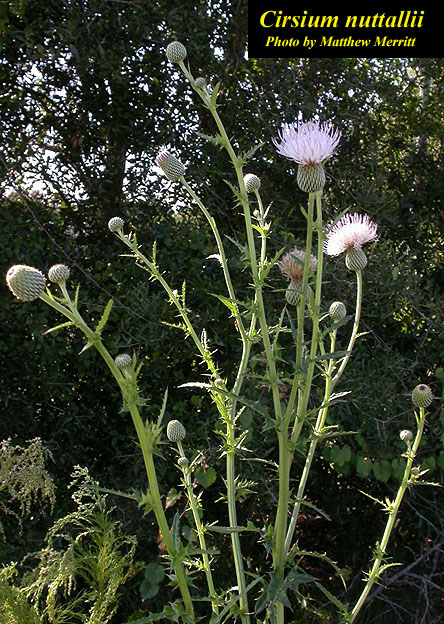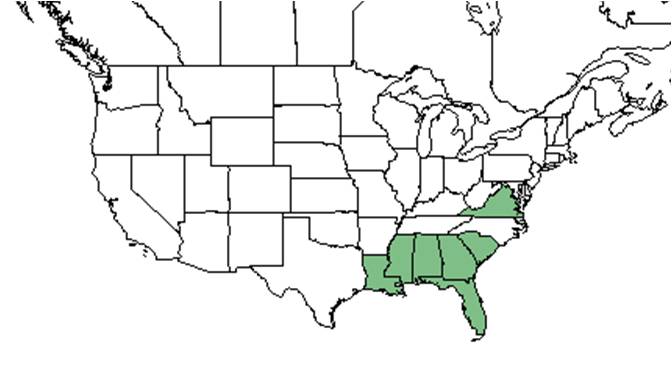Difference between revisions of "Cirsium nuttallii"
HaleighJoM (talk | contribs) (→Ecology) |
|||
| Line 45: | Line 45: | ||
<!--===Fire ecology===--> <!--Fire tolerance, fire dependence, adaptive fire responses--> | <!--===Fire ecology===--> <!--Fire tolerance, fire dependence, adaptive fire responses--> | ||
| − | ===Pollination | + | ===Pollination=== |
| − | ''Cirsium nuttallii'' has been observed at the Archbold Biological Station to host bees from the Apidae family such as ''Apis mellifera'' and ''Bombus griseocollis'', sweat bees such as ''Halictus poeyi'' (family Halictidae), and leafcutting bees such as ''Lithurgus gibbosus'' (family Megachilidae).<ref>Deyrup, M.A. and N.D. 2015. Database of observations of Hymenoptera visitations to flowers of plants on Archbold Biological Station, Florida, USA.</ref> The seeds are eaten by birds, but avoids herbivory from deer.<ref name="Naturescape">[[https://naturescapesofbeaufort.com/products-page/butterfly-larval-food-source/cirsium-nuttallii-coastal-tall-thistle/ Naturescapes of Beaufort, SC]]Accessed: December 7, 2015</ref> It is the larval host to the little metalmark butterfly.<ref name="What">[[https://whatfloridanativeplantisbloomingtoday.wordpress.com/2014/04/26/nuttalls-thistle-cirsium-nuttallii-2/ What Florida Native Plant is Blooming Today]]Accessed: December 7, 2015</ref> | + | ''Cirsium nuttallii'' has been observed at the Archbold Biological Station to host bees from the Apidae family such as ''Apis mellifera'' and ''Bombus griseocollis'', sweat bees such as ''Halictus poeyi'' (family Halictidae), and leafcutting bees such as ''Lithurgus gibbosus'' (family Megachilidae).<ref>Deyrup, M.A. and N.D. 2015. Database of observations of Hymenoptera visitations to flowers of plants on Archbold Biological Station, Florida, USA.</ref> |
| + | |||
| + | ===Herbivory and toxicology=== | ||
| + | The seeds are eaten by birds, but avoids herbivory from deer.<ref name="Naturescape">[[https://naturescapesofbeaufort.com/products-page/butterfly-larval-food-source/cirsium-nuttallii-coastal-tall-thistle/ Naturescapes of Beaufort, SC]]Accessed: December 7, 2015</ref> It is the larval host to the little metalmark butterfly.<ref name="What">[[https://whatfloridanativeplantisbloomingtoday.wordpress.com/2014/04/26/nuttalls-thistle-cirsium-nuttallii-2/ What Florida Native Plant is Blooming Today]]Accessed: December 7, 2015</ref> | ||
<!--===Diseases and parasites===--> | <!--===Diseases and parasites===--> | ||
Revision as of 12:35, 22 June 2022
| Cirsium nuttallii | |
|---|---|

| |
| Photo by Matthew Merritt, Atlas of Florida Vascular Plants | |
| Scientific classification | |
| Kingdom: | Plantae |
| Division: | Magnoliophyta - Flowering plants |
| Class: | Magnoliopsida - Dicotyledons |
| Order: | Asterales |
| Family: | Asteraceae ⁄ Compositae |
| Genus: | Cirsium |
| Species: | C. nuttallii |
| Binomial name | |
| Cirsium nuttallii DC. | |

| |
| Natural range of Cirsium nuttallii from USDA NRCS Plants Database. | |
Common names: Nuttall's thistle; coastal tall thistle
Contents
Taxonomic notes
Synonyms: Carduus nuttallii (A.P. de Candolle) Pollard.[1]
Varieties: none.[1]
Description
A description of Cirsium nuttallii is provided in The Flora of North America.
C. nuttallii is a biennial species that develops a deep taproot and basal rosette the first year, then shoots up a single, erect, glabrous stem.[2][3] It can be distinguished from other Cirsium by having branched and many-headed stems.[4]
Distribution
Ecology
Habitat
In the Coastal Plain in Florida and Georgia, C. nuttallii can be found in loamy sand of pine savannas, Hymenachne depressions, and freshwater marsh banks. It will grow in sunny, open and disturbed habitats such as roadsides, railroad tracks, pastures, levees, highways, and upland fallow fields.[2][5]
Cirsium nuttallii is an indicator species for the Calcareous Savannas community type as described in Carr et al. (2010).[6]
Phenology
Cirsium nuttallii has been observed flowering April through July with peak inflorescence in June and with white to pink flowers.[2][7]
Seed bank and germination
It produces a large number of seeds and has been observed to self-sow freely.[2][8]
Pollination
Cirsium nuttallii has been observed at the Archbold Biological Station to host bees from the Apidae family such as Apis mellifera and Bombus griseocollis, sweat bees such as Halictus poeyi (family Halictidae), and leafcutting bees such as Lithurgus gibbosus (family Megachilidae).[9]
Herbivory and toxicology
The seeds are eaten by birds, but avoids herbivory from deer.[10] It is the larval host to the little metalmark butterfly.[11]
Conservation, cultivation, and restoration
Global Conservation Status: G5.[12]
Cultural use
The leaves and stems can be cooked, so keeping it as a potherb is a possibility.[13]
Photo Gallery
References and notes
- ↑ 1.0 1.1 Weakley, A.S. 2015. Flora of the southern and mid-atlantic states. Working Draft of 21 May 2015. University of North Carolina at Chapel Hill, Chapel Hill, North Carolina.
- ↑ 2.0 2.1 2.2 2.3 [Native Florida Wildflowers]Accessed:December 7, 2015
- ↑ [Encyclopedia of Life] Accessed: December 7, 2015
- ↑ Krings, Alexander, Randy Westbrooks, and Janine Lloyd. “CIRSIUM NUTTALLII (ASTERACEAE: CYNAREAE) NEW TO NORTH CAROLINA AND AN ILLUSTRATED KEY TO SOUTHEASTERN CONGENERS”. SIDA, Contributions to Botany 20.2 (2002): 845–848.
- ↑ Florida State University Robert K. Godfrey Herbarium database. URL: http://herbarium.bio.fsu.edu. Last accessed: October 2015. Collectors: Loran C. Anderson, James R. Birkhaulter, D. Burch, Emily Earp, R.K. Godfrey, R. Komarek, Marc Minno, Paul L. Redfearn Jr., Cecil R. Slaughter, L.B. Trott, D.B. Ward. States and Counties: Florida: Brevard, Escambia, Gadsden, Jefferson, Lee, Leon, Palm Beach, Polk, Putnam, Taylor, Wakulla. Georgia: Grady. Compiled by Tall Timbers Research Station and Land Conservancy.
- ↑ Carr, S.C., K.M. Robertson, and R.K. Peet. 2010. A vegetation classification of fire-dependent pinelands of Florida. Castanea 75:153-189.
- ↑ Nelson, G. PanFlora: Plant data for the eastern United States with emphasis on the Southeastern Coastal Plains, Florida, and the Florida Panhandle. www.gilnelson.com/PanFlora/ Accessed: 7 DEC 2016
- ↑ [Dave's Garden]Accessed: December 7, 2015
- ↑ Deyrup, M.A. and N.D. 2015. Database of observations of Hymenoptera visitations to flowers of plants on Archbold Biological Station, Florida, USA.
- ↑ [Naturescapes of Beaufort, SC]Accessed: December 7, 2015
- ↑ [What Florida Native Plant is Blooming Today]Accessed: December 7, 2015
- ↑ [NatureServe]Accessed: December 7, 2015
- ↑ Fernald, et al. 1958. Edible Plants of Eastern North America. Harper and Row Publishers, New York.